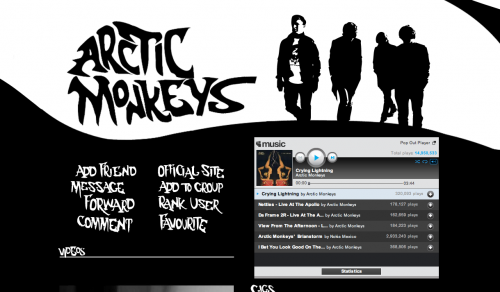How Justin Bieber And The Arctic Monkeys Have Used Social Media To Launch Their Careers In Different Eras
They may be from different parts of the world, they may make very different music and are into very different things, one of them might not have even heard of the other 4, but this odd match once shared a very similar approach when it came to winning fans and capturing hearts.
It was ten years ago this month that the Arctic Monkeys released their debut album Whatever People Say I am Is What I’m Not. And while Conor McNicholas, former editor of the ever-demising NME, recently described the band as the music magazines cause of death, we prefer to attribute to the Sheffield foursome something more creative, intelligent and generally, more optimistic. Their daringly unique handling of social media in general and MySpace in particular, back in late 2005 successfully landed them on the fast-track to fame and recognition and contributed to the evolution of the way we discover and listen to music today.
In the truest sense of rock n roll, the Arctic Monkeys are a DIY band. By the time their debut album was released in January 2006, they already had a well-established fan-base that had on their series one-iPod shuffles a whole host of Monkeys material that record labels and Radio 1 DJs alike didn’t even know existed. Whereas in the past the majority of young, unsigned bands avoided giving away their music online like an indie kid avoids a bath, the Arctic Monkeys rightfully saw it as a means of getting their music heard and embraced it with both barrels. In sharing their music on MySpace and encouraging their friends and fans to do the same, they introduced to the mainstream the blueprint of a new dynamic to social media and, back then, a whole new incentive to engage and communicate with
Whereas in the past the majority of young, unsigned bands avoided giving away their music online like an indie kid avoids a bath, the Arctic Monkeys rightfully saw it as a means of getting their music heard and embraced it with both barrels. In sharing their music on MySpace and encouraging their friends and fans to do the same, they introduced to the mainstream the blueprint of a new dynamic to social media and, back then, a whole new incentive to engage and communicate with like-minded souls online.
The band’s contribution to the formation of active, online fanbases and communities has helped shift the power from the music industry over to social media just ten years later. Post-2005 we have sites like Soundcloud, Mixcloud, Last.fm and countless other forums for fans to connect and for artists to share their music and capture an audience. Perhaps the most blatant example of this comes in the form of one-time YouTube sensation turned global megastar Justin Bieber whose success story would be a lot less successful had he (or his Mum) not taken matters into their own hands back in 2009. In a similar way to the Arctic Monkeys, Biebs watched his online profile grow and grow before the powers that be snapped him up and signed him to a record company.
However, Bieber has gone where the Monkeys haven’t. Back in 2006 the Arctic Monkeys unlocked a door and made music more accessible via social media. Through that door entered Bieber; a pop star in the making who went onto to transform himself into an extremely desirable, and at the same time, easily accessible business model via the shrewd use of social media. Thousands of views on YouTube progressed into 74.3 million twitter followers, 55.5 million Instagram followers and obscene amounts of money changing hands for tickets to his live shows just about everywhere else online.
The digital age is fast-paced one of progression and evolution; all bets are now on to see who will be the next predecessor to these digital darlings.
By Aisling Lewis
Join the conversation #TheFutureOfMarketing

